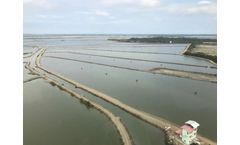Refine by
Broodstock Articles & Analysis
19 articles found
The mean volume of eggs produced by both broodstocks was 405 ± 13.4 mL with a fertilization rate of 91.6 ± 0.4%. ...
ByIRTAmar
A major source of diseases in farmed shrimp is a result of the carry-over of obligate pathogens from broodstock. PCR testing of populations using the standard statistical approach can result in animals carrying pathogens below the threshold. ...
The presence or absence of a pathogen in captive broodstock held in a biosecure environment should not be based on population sampling. ...
There are no consequences except to the poor shrimp farmers either way. Every company that produces broodstock for export is required to test their populations for a list of known pathogens in order to be able to legally export/import the animals. ...
The presence or absence of a pathogen in captive broodstock held in a biosecure environment should not be based on population sampling. ...
Both fish and crustaceans live in an immersed aquatic environment, where their chemioperceptive system receives permanent stimulation by soluble compounds. These substances are usually of low molecular weight, non-volatile and most of them contain nitrogen (amino acids, nucleotides, etc.). These compounds stimulate the chemioperception of the animal (taste and smell), and its behavior (feeding ...
PATHOGENS IN PRODUCTION SYSTEMS Shrimp aquaculture consists of three or four distinct stages. Broodstock production, production of larval and post larval shrimp, nursery ponds that bridge this to the farm and finally on the farm production. ...
Aquaculture is growing at a greater rate globally than any other agribusiness sector. It is widely predicted that with 6 to 8% annual growth rate continuing well into the foreseeable future, aquaculture will offer good investment opportunities. However, just like any other endeavor, there are some very good reasons why what some see as a pot of gold at the end of the rainbow is empty and full of ...
Shrimp are one of the most popular aquaculture species in the Philippines. Shrimp farming can be highly profitable, with higher harvest rates and relatively low production costs compared to other species when standardized, sustainable aquaculture approaches are followed. Disease outbreaks over the last two decades, however, have led to dramatic declines in the shrimp output and challenges for ...
Application of Genomic Selection for BCWD resistance to three generations of Troutlodge broodstock resulted in a challenge survival increasing from 33.5% in 2015 to 78.3% in 2019. ...
Therefore, 7 to 10 days before broodstock or freshly hatched tilapia fall into the pond, start to apply inorganic or organic fertilizers in spawning ponds and fingerling breeding ponds. ...
Overview Andy Jones compares the catfish industry to the jagged graph of a heartbeat displayed on an EKG machine. The peaks and valleys of that pulsating line are a vivid metaphor for the fluctuating fortunes of a seasonal business dependent on live animals and a dynamic market. Jones is in a good position to make the connection. As a second-generation catfish farmer, he’s seen firsthand ...
OVERVIEW Andy Jones compares the catfish industry to the jagged graph of a heartbeat displayed on an EKG machine. The peaks and valleys of that pulsating line are a vivid metaphor for the fluctuating fortunes of a seasonal business dependent on live animals and a dynamic market. Jones is in a good position to make the connection. As a secondgeneration catfish farmer, he’s seen firsthand ...
Yellow Head Virus (YHV) Yellow Head Virus was the first major viral disease problem to affect Asian shrimp farms when it was diagnosed as causing extensive losses for shrimp farming. YHV and its close relatives GAV and LOVV are single stand RNA viruses, similar to TSV. The first records of this virus were from P. monodon ponds in Eastern Thailand, it had moved to Southern Thailand and was ...
ByVinnbio
Similar problems have occurred throughout Central and South America, with the exception of Brazil and Venezuela, which remain WSSV-free due to the prompt and effective closure of their borders to all crustacean imports.The United States also managed to eradicate WSSV from its shrimp culture industry after initial losses through implementation of biosecurity measures, including the use of all SPF ...
ByVinnbio
This virus was first discovered in P. vannamei and P. stylirostris in the America, starting in Hawaii. However, it was probably not an indigenous virus, but was thought to have been introduced along with live P.monodon from Asia. IHHNV has probably existed for some time in Asia without detection due to its insignificant effects on P. monodon, the major cultured species in Asia, meaning that ...
ByVinnbio
In Shrimp Disease control, they are Six viruses were known to affect Penaeid shrimp, but there are more than 20 viruses were identified as having affected wild stocks and commercial production. The OIE now lists seven viral diseases of shrimp in the Aquatic Animal Health Code, which are considered to be transmissible and of significant socio-economic and/or public health importance. These ...
ByVinnbio
There is no evidence that it can be transmitted via broodstock and there is increasing evidence that simply modifying cultural practices can address whatever the underlying cause ...
Changes in the government's role, public policy and support mechanisms, particularly via the industry cluster approach, are considered to be important driving factors.Keywords: aquaculture, aquacultural biotechnology, shrimp industry, Thailand, P monodon, black tiger shrimp, shrimp disease prevention, diagnostic kits, public policy, broodstock, policy lessons, shrimp clusters, ...










